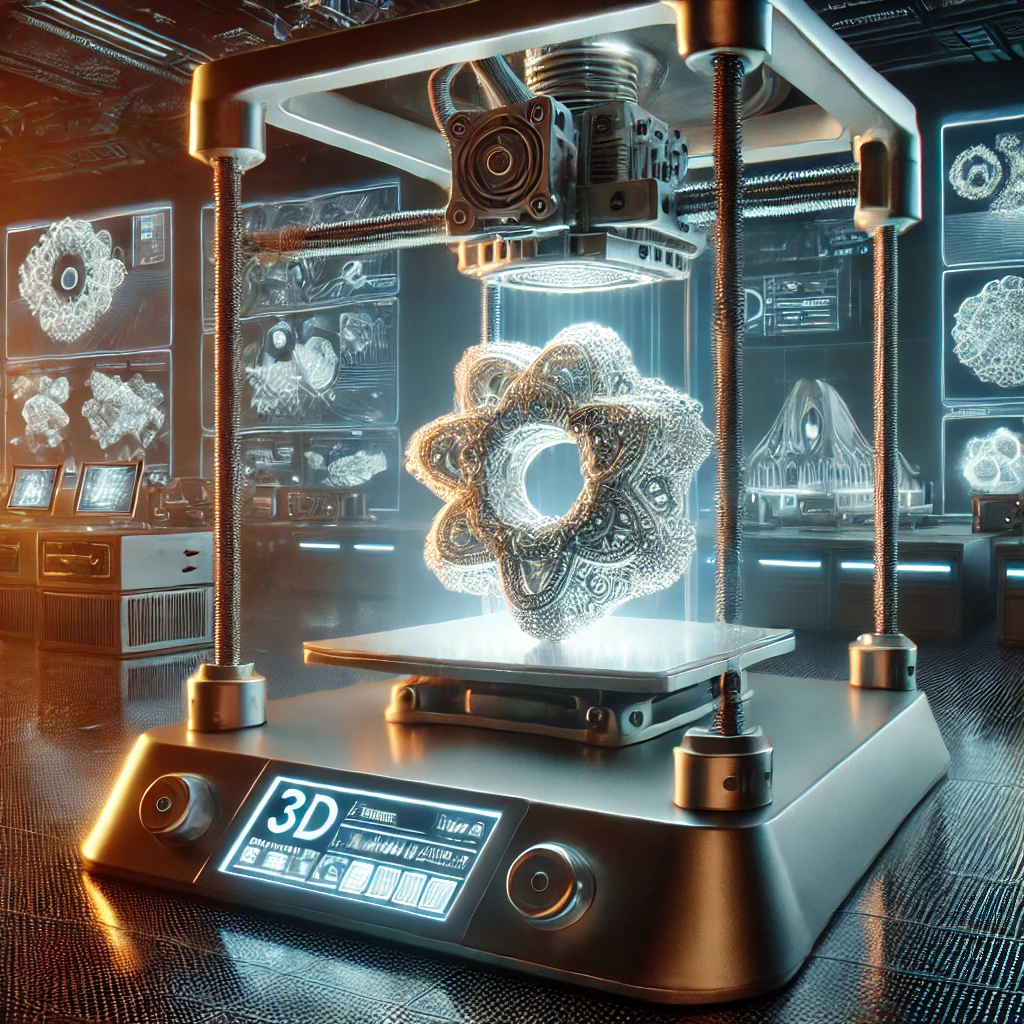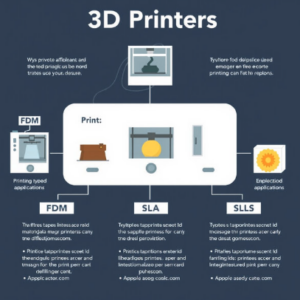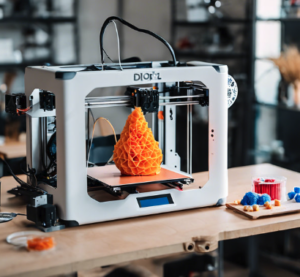A Detailed Look at 3D Printing: Revolutionizing Manufacturing and Design

The Evolution of 3D Printing
Brief History and Origin of 3D Printing
The journey of 3D printing, also known as additive manufacturing, dates back to the early 1980s when Chuck Hull invented the technology. Hull’s pioneering work led to the development of stereolithography, a method that involved curing resin with ultraviolet light. This method, now known as SLA (stereolithography), was initially designed for rapid prototyping in industries like automotive and aerospace. The potential for 3D printing was realized when companies saw its ability to create highly complex parts without the need for molds or traditional manufacturing processes.
As the years passed, various other 3D printing technologies emerged, including FDM (Fused Deposition Modeling) and SLS (Selective Laser Sintering), each offering distinct advantages. The introduction of materials such as thermoplastics, metals, and resins has expanded the possibilities of 3D printing, making it more accessible and suitable for different industries. Today, 3D printing is no longer limited to prototyping; it is used for full-scale production across a variety of sectors.
Definition and Basic Principles
3D printing works by adding material layer by layer to create an object from a digital model. Unlike traditional manufacturing processes, which are subtractive, 3D printing is additive. This means that the material is built up gradually, minimizing waste and enabling more complex shapes. A digital model created through CAD (Computer-Aided Design) software is sliced into thin layers, which the 3D printer then replicates. Each layer adheres to the one beneath it, gradually building up the final object.
The process allows for unparalleled customization and flexibility in design. Additionally, 3D printing can be used for various materials, ranging from common plastics like PLA (Polylactic Acid) to high-performance metals and ceramics. This versatility has enabled industries to produce parts that were previously impossible to create with traditional methods.
Impact on Manufacturing and Design
3D printing has had a revolutionary impact on both manufacturing and design. In traditional manufacturing, the production of goods often requires molds, tooling, and long lead times. However, 3D printing eliminates these requirements, offering companies faster and more cost-effective methods to produce customized products. In design, the technology allows for greater freedom of creativity, enabling designers to explore complex geometries and innovative shapes that would have been costly or time-consuming to manufacture using traditional methods.
For manufacturers, the ability to create prototypes quickly allows for iterative testing, reducing the time spent on product development. Rapid prototyping has become a key advantage for industries such as automotive, aerospace, and consumer electronics, where the ability to test and refine designs quickly is crucial. In many cases, 3D printing reduces the time to market for new products, making companies more agile in their operations.
Key Industry Adoption
Several industries have integrated 3D printing into their processes, significantly transforming production methods. The automotive industry, for example, has adopted 3D printing to create lightweight parts that reduce vehicle weight and improve fuel efficiency. Companies like Ford and BMW have used the technology to print everything from custom tools to spare parts, increasing efficiency in their supply chains.
The healthcare sector is another area where 3D printing is making a difference. Custom prosthetics and implants are now being produced using 3D printing, offering patients highly personalized and functional solutions. For instance, 3D-printed hearing aids are now common, providing individuals with devices tailored to their specific needs. Furthermore, advancements in bio-printing hold the potential to print tissues and even organs, which could one day revolutionize organ transplantation.
In aerospace, 3D printing is used to manufacture lightweight yet durable components for aircraft and spacecraft. By using 3D-printed parts, companies like Boeing and Airbus have been able to reduce the weight of their aircraft, leading to fuel savings and lower emissions. The technology is also being used to print tools, reducing reliance on bulky inventory and improving maintenance turnaround times.
Challenges Faced in the Early Days
Although 3D printing holds immense potential, it faced several challenges in its early stages. One of the main hurdles was the high cost of 3D printers and materials, which limited their accessibility to large corporations and research institutions. The first 3D printers were slow, taking hours or even days to produce a single object. Additionally, the range of materials available was limited, and the quality of prints was often subpar, with rough surfaces and poor structural integrity.
The learning curve was steep, and designers had to develop new skills to create 3D models that were compatible with printing processes. Furthermore, the process of post-processing, which includes removing support structures and finishing the printed part, was time-consuming and required specialized knowledge.
Technological Advancements Over Time
Since its inception, 3D printing has undergone significant advancements. The introduction of new materials, such as carbon fiber composites and high-strength metals, has expanded the range of applications for the technology. As the materials used in 3D printing have evolved, so too have the printing methods. For instance, faster printing speeds and enhanced precision have made it possible to create more complex and high-quality products in less time.
Improved software tools have also played a critical role in the evolution of 3D printing. The development of slicing software has enabled designers to optimize their 3D models for printing, resulting in better quality prints with fewer defects. Additionally, advancements in printer hardware have made 3D printing more affordable and accessible to a broader range of industries.
Looking Toward the Future
The future of 3D printing looks incredibly promising. Researchers are exploring the potential of bio-printing, where cells and tissues are printed layer by layer to create functional biological structures. This technology could one day enable the printing of organs, offering hope to millions of people on organ transplant waiting lists.
In the construction industry, 3D printing is expected to revolutionize the way buildings are designed and constructed. 3D-printed houses have already been built, showcasing the potential for cost-effective and sustainable construction practices. As 3D printing continues to advance, it is likely that we will see even more innovative applications across various industries, from space exploration to consumer products.
How 3D Printing Works – A Step-by-Step Breakdown
The Role of 3D Models
The first step in 3D printing is creating a 3D model. Designers typically use CAD (Computer-Aided Design) software to design a digital model of the object. CAD software allows for precise measurements, ensuring that every aspect of the design is accurate. Once the design is complete, it is converted into a digital file format that the 3D printer can interpret, typically STL (stereolithography) or OBJ formats.
The model is then “sliced” into thin layers using slicing software, which prepares it for printing. Each layer corresponds to a very thin cross-section of the final product, and the 3D printer will create each layer one at a time.
Layer-by-Layer Printing Process
The core principle of 3D printing is layer-by-layer manufacturing. The printer begins by laying down the first layer of material on the print bed. As the printing process progresses, each layer is added on top of the previous one, gradually building the object from the bottom up. This method of additive manufacturing allows for highly intricate designs that would be difficult to achieve with traditional subtractive processes.
Each layer is very thin—usually between 0.1 to 0.3 millimeters—ensuring that the final object is precise and accurate. The printing process is relatively slow, with more intricate objects requiring more time to complete. However, the ability to produce complex designs without the need for molds or tooling is a key advantage of 3D printing.
Materials Used in 3D Printing
The materials used in 3D printing vary depending on the printer and the intended application. Common materials include PLA (Polylactic Acid), which is a biodegradable plastic, and ABS (Acrylonitrile Butadiene Styrene), known for its strength and flexibility. These materials are suitable for general-purpose applications, such as prototyping and producing consumer goods.
More advanced 3D printers can handle a wide range of materials, including metals, ceramics, and composites. In industries like aerospace and automotive, 3D printing with metals such as titanium and aluminum is increasingly common due to their strength and lightweight properties. Researchers are also developing bioresins and other innovative materials for specialized applications, including bio-printing in the medical field.
Types of 3D Printing Technologies
There are several different types of 3D printing technologies, each suited for specific applications. Some of the most common methods include:
-
FDM (Fused Deposition Modeling): This is the most widely used 3D printing method, where a heated filament of material is extruded through a nozzle and deposited layer by layer.
-
SLA (Stereolithography): In SLA, a laser cures liquid resin layer by layer, producing highly detailed prints with smooth finishes.
-
SLS (Selective Laser Sintering): SLS uses a laser to sinter powdered material (often nylon or metal), fusing it together to create a solid object.
Each of these technologies has its advantages and limitations, making them more suitable for different types of projects. For example, FDM is affordable and widely accessible, while SLA offers high precision for detailed models.
Printer Components
3D printers are composed of several key components, including the print bed, the extruder, and the controller. The print bed is the surface on which the object is built, and it may be heated to help materials stick better. The extruder is responsible for feeding the material through the nozzle, where it is melted or cured and then deposited onto the print bed.
The controller is the brain of the printer, interpreting the 3D model and directing the movements of the extruder and print bed. Some advanced printers feature multiple extruders, allowing them to print with different materials or colors simultaneously.
Post-Processing and Finishing
After printing, most 3D-printed objects require post-processing. This can include removing support structures, sanding the surface to smooth out rough edges, or painting the object to improve its appearance. Post-processing is particularly important for models printed using SLA or SLS technologies, as these methods often leave behind rough surfaces or residual material that needs to be cleaned up.
In some cases, additional curing under UV light may be necessary to fully harden the print. The post-processing steps can be time-consuming but are essential for achieving a high-quality, functional final product.
Potential for Automation and AI
The future of 3D printing is poised to benefit from advancements in automation and artificial intelligence (AI). AI algorithms are already being used to optimize design files, improving efficiency and reducing material waste. Machine learning can also help detect and correct potential printing errors before they occur, ensuring that the final product meets high standards of quality.
Automation in post-processing, such as robotic sanding and painting, is also becoming more common. These advancements are making 3D printing faster, more cost-effective, and more capable of handling larger-scale production.




